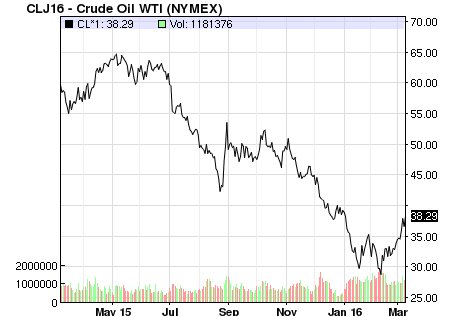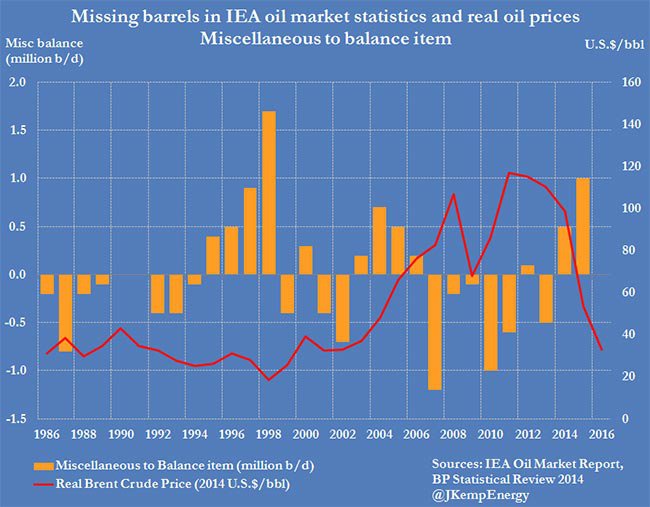Crude oil inventories peaking as 550 million barrels go walkabout
Published 10-MAR-2016 10:44 A.M.
|
3 minute read
Hey! Looks like you have stumbled on the section of our website where we have archived articles from our old business model.
In 2019 the original founding team returned to run Next Investors, we changed our business model to only write about stocks we carefully research and are invested in for the long term.
The below articles were written under our previous business model. We have kept these articles online here for your reference.
Our new mission is to build a high performing ASX micro cap investment portfolio and share our research, analysis and investment strategy with our readers.
Click Here to View Latest Articles
Despite US crude oil stockpiles remaining close to their record highs for a fourth week, crude prices spiked 5% higher in overnight trading in the US.
In a keenly awaited announcement by oil traders, the US Energy Information Administration (EIA) said crude stockpiles rose 3.9 million barrels to nearly 522 million barrels, in line with consensus estimates from top analysts surveyed by Reuters.
Gasoline inventories fell by 4.5 million barrels, significantly worse than the 1.4 million barrel decline expected.
A large draw in US gasoline inventories was seen by some analysts as confirmation that energy demand was starting to improve in North America. Meanwhile, large oil producing nations including OPEC are rumoured to be considering an output reduction to help prices recover further.
US crude futures settled US$1.79 higher, or 4.9% at $38.29 a barrel in the US trading session overnight. Brent crude futures rose $1.29 to $40.94 a barrel, having already touched three-month highs on Tuesday above $41.

Prior to the publication of the latest crude oil inventory numbers, crude prices received a bid after an oil official from the Iraqi oil ministry revealed that a major meeting between the top oil producing countries would take place on 20 March in Moscow. Market participants jumped on the development as a possible early indicator for an output cut.
Several hours after the rumour was picked up by international news agencies, the alleged meeting has still not been confirmed by the Russian energy ministry or any other official sources.
Since mid-February, crude oil prices have risen 25% on the back of an agreement between Saudi Arabia, Qatar, Venezuela (OPEC) and Russia (non-OPEC) to leave supply at January’s levels.
The Case of the Missing Barrels
In February’s oil market report, the EIA said that 550 million barrels could not be accounted for and were therefore “missing”.
According to Reuters and the International Energy Agency (IEA), global oil production exceeded consumption by just over 1 billion barrels in 2014/15. Production exceeded consumption by an average of 0.9 million barrels per day in 2014 and 2.0 million bpd in 2015.
Of the 1 billion barrels reportedly produced but not consumed, roughly 420 million are being stored on land in member countries of the Organisation for Economic Cooperation and Development (OECD).
Another 75 million barrels are thought to be stored at sea or in transit by tanker somewhere from the oil fields to the refineries.
When tallying up the ‘miscellaneous’ items that reflect data errors in IEA’s reporting, it would appear 550 million barrels of oil have not been accounted for, and therefore, could come back onto the market once statistical disparities have been ironed out.

The last time the miscellaneous balance item was this large and positive (implying an oversupplied market) was in 1997/98 when the issue triggered fierce criticism of the IEA’s statistics.
Critics accused the IEA of over-estimating supply, under-estimating demand, contributing to perception of a glut, depressing prices, and causing unnecessary hardship to the oil industry.
In an article published in November last year, The Financial Times (FT) reported that the “amount of oil at sea is at least double the levels of earlier this year and is equivalent to more than a day of global oil supply”. The falling oil price over the past few years has effectively created an ‘in-transit glut’ that acts as an additional downside pressure on prices. In the article, the FT estimated that Asia’s main oil hub had around 35 million barrels stuck in transit, the US Gulf of Mexico has 20 million barrels and UAE 8 million.
General Information Only
S3 Consortium Pty Ltd (S3, ‘we’, ‘us’, ‘our’) (CAR No. 433913) is a corporate authorised representative of LeMessurier Securities Pty Ltd (AFSL No. 296877). The information contained in this article is general information and is for informational purposes only. Any advice is general advice only. Any advice contained in this article does not constitute personal advice and S3 has not taken into consideration your personal objectives, financial situation or needs. Please seek your own independent professional advice before making any financial investment decision. Those persons acting upon information contained in this article do so entirely at their own risk.
Conflicts of Interest Notice
S3 and its associated entities may hold investments in companies featured in its articles, including through being paid in the securities of the companies we provide commentary on. We disclose the securities held in relation to a particular company that we provide commentary on. Refer to our Disclosure Policy for information on our self-imposed trading blackouts, hold conditions and de-risking (sell conditions) which seek to mitigate against any potential conflicts of interest.
Publication Notice and Disclaimer
The information contained in this article is current as at the publication date. At the time of publishing, the information contained in this article is based on sources which are available in the public domain that we consider to be reliable, and our own analysis of those sources. The views of the author may not reflect the views of the AFSL holder. Any decision by you to purchase securities in the companies featured in this article should be done so after you have sought your own independent professional advice regarding this information and made your own inquiries as to the validity of any information in this article.
Any forward-looking statements contained in this article are not guarantees or predictions of future performance, and involve known and unknown risks, uncertainties and other factors, many of which are beyond our control, and which may cause actual results or performance of companies featured to differ materially from those expressed in the statements contained in this article. S3 cannot and does not give any assurance that the results or performance expressed or implied by any forward-looking statements contained in this article will actually occur and readers are cautioned not to put undue reliance on forward-looking statements.
This article may include references to our past investing performance. Past performance is not a reliable indicator of our future investing performance.
